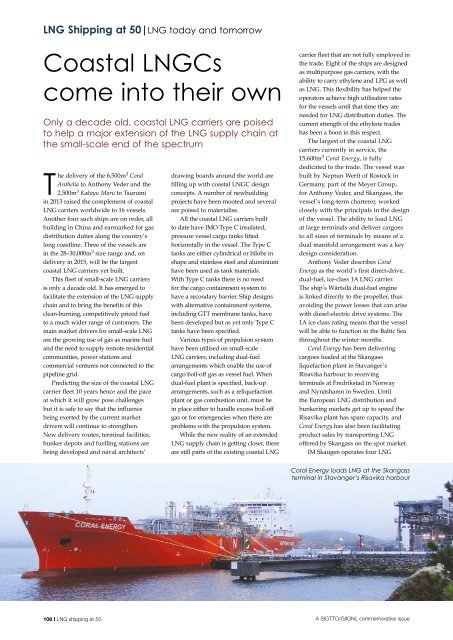You also want an ePaper? Increase the reach of your titles
YUMPU automatically turns print PDFs into web optimized ePapers that Google loves.
LNG Shipping at 50|LNG today and tomorrow<br />
Coastal LNGCs<br />
come into their own<br />
Only a decade old, coastal LNG carriers are poised<br />
to help a major extension of the LNG supply chain at<br />
the small-scale end of the spectrum<br />
The delivery of the 6,500m 3 Coral<br />
Anthelia to Anthony Veder and the<br />
2,500m 3 Kakayu Maru to Tsurumi<br />
in 2013 raised the complement of coastal<br />
LNG carriers worldwide to 16 vessels.<br />
Another four such ships are on order, all<br />
building in China and earmarked for gas<br />
distribution duties along the country’s<br />
long coastline. Three of the vessels are<br />
in the 28–30,000m 3 size range and, on<br />
delivery in 2015, will be the largest<br />
coastal LNG carriers yet built.<br />
This fleet of small-scale LNG carriers<br />
is only a decade old. It has emerged to<br />
facilitate the extension of the LNG supply<br />
chain and to bring the benefits of this<br />
clean-burning, competitively priced fuel<br />
to a much wider range of customers. The<br />
main market drivers for small-scale LNG<br />
are the growing use of gas as marine fuel<br />
and the need to supply remote residential<br />
communities, power stations and<br />
commercial ventures not connected to the<br />
pipeline grid.<br />
Predicting the size of the coastal LNG<br />
carrier fleet 10 years hence and the pace<br />
at which it will grow pose challenges<br />
but it is safe to say that the influence<br />
being exerted by the current market<br />
drivers will continue to strengthen.<br />
New delivery routes, terminal facilities,<br />
bunker depots and fuelling stations are<br />
being developed and naval architects’<br />
drawing boards around the world are<br />
filling up with coastal LNGC design<br />
concepts. A number of newbuilding<br />
projects have been mooted and several<br />
are poised to materialise.<br />
All the coastal LNG carriers built<br />
to date have IMO Type C insulated,<br />
pressure vessel cargo tanks fitted<br />
horizontally in the vessel. The Type C<br />
tanks are either cylindrical or bilobe in<br />
shape and stainless steel and aluminium<br />
have been used as tank materials.<br />
With Type C tanks there is no need<br />
for the cargo containment system to<br />
have a secondary barrier. Ship designs<br />
with alternative containment systems,<br />
including GTT membrane tanks, have<br />
been developed but as yet only Type C<br />
tanks have been specified.<br />
Various types of propulsion system<br />
have been utilised on small-scale<br />
LNG carriers, including dual-fuel<br />
arrangements which enable the use of<br />
cargo boil-off gas as vessel fuel. When<br />
dual-fuel plant is specified, back-up<br />
arrangements, such as a reliquefaction<br />
plant or gas combustion unit, must be<br />
in place either to handle excess boil-off<br />
gas or for emergencies when there are<br />
problems with the propulsion system.<br />
While the new reality of an extended<br />
LNG supply chain is getting closer, there<br />
are still parts of the existing coastal LNG<br />
carrier fleet that are not fully employed in<br />
the trade. Eight of the ships are designed<br />
as multipurpose gas carriers, with the<br />
ability to carry ethylene and LPG as well<br />
as LNG. This flexibility has helped the<br />
operators achieve high utilisation rates<br />
for the vessels until that time they are<br />
needed for LNG distribution duties. The<br />
current strength of the ethylene trades<br />
has been a boon in this respect.<br />
The largest of the coastal LNG<br />
carriers currently in service, the<br />
15,600m 3 Coral Energy, is fully<br />
dedicated to the trade. The vessel was<br />
built by Neptun Werft of Rostock in<br />
Germany, part of the Meyer Group,<br />
for Anthony Veder, and Skangass, the<br />
vessel’s long-term charterer, worked<br />
closely with the principals in the design<br />
of the vessel. The ability to load LNG<br />
at large terminals and deliver cargoes<br />
to all sizes of terminals by means of a<br />
dual manifold arrangement was a key<br />
design consideration.<br />
Anthony Veder describes Coral<br />
Energy as the world’s first direct-drive,<br />
dual-fuel, ice-class 1A LNG carrier.<br />
The ship’s Wärtsilä dual-fuel engine<br />
is linked directly to the propeller, thus<br />
avoiding the power losses that can arise<br />
with diesel-electric drive systems. The<br />
1A ice class rating means that the vessel<br />
will be able to function in the Baltic Sea<br />
throughout the winter months.<br />
Coral Energy has been delivering<br />
cargoes loaded at the Skangass<br />
liquefaction plant in Stavanger’s<br />
Risavika harbour to receiving<br />
terminals at Fredrikstad in Norway<br />
and Nynäshamn in Sweden. Until<br />
the European LNG distribution and<br />
bunkering markets get up to speed the<br />
Risavika plant has spare capacity, and<br />
Coral Energy has also been facilitating<br />
product sales by transporting LNG<br />
offered by Skangass on the spot market.<br />
IM Skaugen operates four LNG<br />
Coral Energy loads LNG at the Skangass<br />
terminal in Stavanger’s Risavika harbour<br />
106 I LNG shipping at 50<br />
A SIGTTO/GIIGNL commemorative issue


